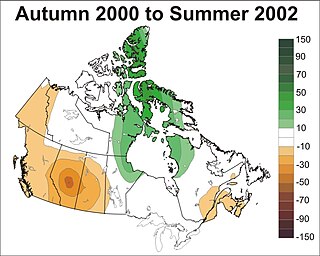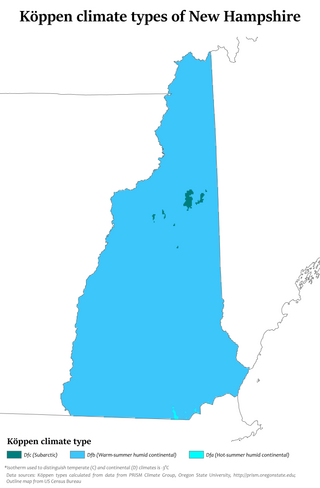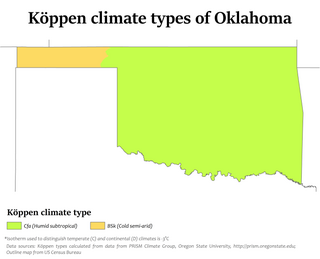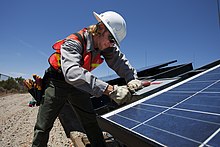
The mountain pine beetle is a species of bark beetle native to the forests of western North America from Mexico to central British Columbia. It has a hard black exoskeleton, and measures approximately 5 millimetres, about the size of a grain of rice.

In hydrology, snowmelt is surface runoff produced from melting snow. It can also be used to describe the period or season during which such runoff is produced. Water produced by snowmelt is an important part of the annual water cycle in many parts of the world, in some cases contributing high fractions of the annual runoff in a watershed. Predicting snowmelt runoff from a drainage basin may be a part of designing water control projects. Rapid snowmelt can cause flooding. If the snowmelt is then frozen, very dangerous conditions and accidents can occur, introducing the need for salt to melt the ice.
The subnivean climate is the environment between fallen snow and terrain. This is the environment of many hibernal animals, as it provides insulation and protection from predators. The subnivean climate is formed by three different types of snow metamorphosis: destructive metamorphosis, which begins when snow falls; constructive metamorphosis, the movement of water vapor to the surface of the snowpack; and melt metamorphosis, the melting/sublimation of snow to water vapor and its refreezing in the snowpack. These three types of metamorphosis transform individual snowflakes into ice crystals and create spaces under the snow where small animals can move.

Climate change in the US state of Washington is a subject of study and projection today. The major impacts of climate change in Washington State include increase in carbon dioxide levels, increase in temperatures, earlier annual snow melt, sea level rise, and others.

Climate change in California has resulted in higher than average temperatures, leading to increased occurrences of droughts and wildfires. Over the next few decades in California, climate change is likely to further reduce water availability, increase wildfire risk, decrease agricultural productivity, and threaten coastal ecosystems. The state will also be impacted economically due to the rising cost of providing water to its residents along with revenue and job loss in the agricultural sector. Economic impacts also include inflation from rising insurance premiums, energy costs and food prices. California has taken a number of steps to mitigate impacts of climate change in the state.

On a per-person basis, Wyoming emits more carbon dioxide than any other state or any other country: 276,000 pounds (125,000 kg) of it per capita a year, because of burning coal, which provides nearly all of the state's electrical power.

Like other parts of the world, climate in Idaho has changed dramatically over the geologic history of the Earth. Paleo-climatic records give some indication of these changes. The longest instrumented records of climate in Idaho extend back to the late 1800s. Concern over human induced climate change through the emission of carbon dioxide from fossil fuels and methane from agriculture and industry, are driving research efforts across the state at university, state, and federals levels to understand what the implications of climate change could be in Idaho.

Climate change in Nevada has been measured over the last century, with the average temperature in Elko, Nevada increasing by 0.6 °F (0.33 °C), and precipitation increasing by up to 20% in many parts of the state. These past trends may or may not continue into the future.

Prolonged, large-area droughts are among Canada's costliest natural disasters having major impacts on a wide range of sectors including agriculture, forestry, industry, municipalities, recreation, human health, society and ecosystems. They frequently stress water availability by depleting soil moisture, reducing stream flows, lowering lake and reservoir levels, and diminishing groundwater supplies. This ultimately affects several economic activities including for example, decreased agricultural production, less hydro-electric power generation, and increased freshwater transportation costs. Droughts also create major environmental hazards such as reduced water quality, wetland loss, soil erosion and degradation, and ecological habitat destruction.

Climate change in Arizona encompasses the effects of climate change, attributed to man-made increases in atmospheric carbon dioxide, in the U.S. state of Arizona.

Climate change in Colorado encompasses the effects of climate change, attributed to man-made increases in atmospheric carbon dioxide, in the U.S. state of Colorado.

Climate change in Kansas encompasses the effects of climate change, attributed to man-made increases in atmospheric carbon dioxide, in the U.S. state of Kansas.

Climate change in Nebraska encompasses the effects of climate change, attributed to man-made increases in atmospheric carbon dioxide, in the U.S. state of Nebraska.

Climate change in New Hampshire encompasses the effects of climate change, attributed to man-made increases in atmospheric carbon dioxide, in the U.S. state of New Hampshire.

Climate change in New Mexico encompasses the effects of climate change, attributed to man-made increases in atmospheric carbon dioxide, in the U.S. state of New Mexico.

Climate change in Oklahoma encompasses the effects of climate change, attributed to man-made increases in atmospheric carbon dioxide, in the U.S. state of Oklahoma.

Climate change in Oregon encompasses the effects of climate change, attributed to man-made increases in atmospheric carbon dioxide, in the U.S. state of Oregon.

Climate change in the United States Virgin Islands encompasses the effects of climate change, attributed to man-made increases in atmospheric carbon dioxide, in the U.S. territory of the United States Virgin Islands. The United States Environmental Protection Agency (EPA) has noted a variety of expected consequences of this phenomenon.

Climate change in South Dakota encompasses the effects of climate change, attributed to man-made increases in atmospheric carbon dioxide, in the U.S. state of South Dakota.

The southwestern North American megadrought is an ongoing megadrought in the southwestern region of North America that began in 2000. At least 24 years in length, the drought is the driest multi-decade period the region has seen since at least 800 CE. The megadrought has prompted the declaration of a water shortage at Lake Mead, the largest reservoir in the United States. Climate change models project drier conditions in the region through the end of the 21st century, though climate change mitigation may avoid the most extreme impacts.
























